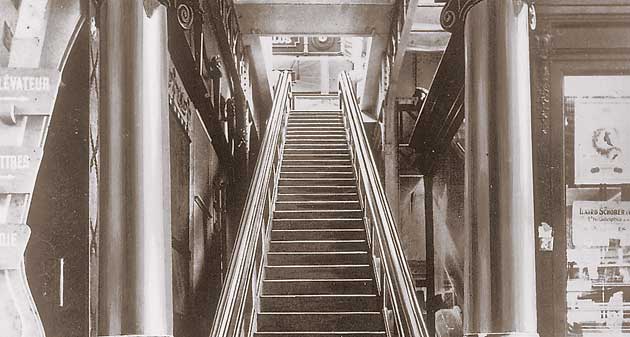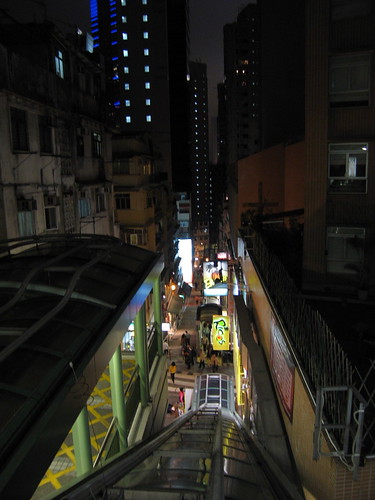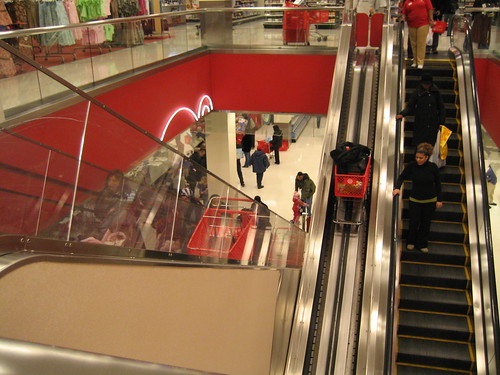going up
One of my favorite comedians, Mitch Hedberg, had a bit about escalators:
"An escalator can never break, it can only become stairs. There would never be an 'Escalator temporarily out of order' sign, only an 'Escalator temporarily stairs. Sorry for the convenience.'"
 Escalator (permanent marker on escalator, 2003) by Ulrich Vogl. Via Bird to the North.
Escalator (permanent marker on escalator, 2003) by Ulrich Vogl. Via Bird to the North.
Escalators are, in fact, incredible machines. They give their users a status somewhere between pedestrian and passenger, providing a remarkably public mode of personal transportation. Ubiquitous in the world's subway stations and department stores, new escalators continue to shape both transit and retail.
 Jesse Reno's 1891 design for the moving stairwell at Coney Island. Ladies were expected to ride 'sidesaddle.' Via The Elevator Museum.
Jesse Reno's 1891 design for the moving stairwell at Coney Island. Ladies were expected to ride 'sidesaddle.' Via The Elevator Museum.
Escalators as we know them today were introduced at the Exposition Universelle of 1900 in Paris, an event better remembered for the introduction of 'Talking Films'. Built by the Otis elevator company, this escalator improved on several earlier versions of inclined people-movers, including one at Coney Island that used seats like a bicycle's.
 The Otis moving stairway at the Exposition Universelle, 1900.
The Otis moving stairway at the Exposition Universelle, 1900.
Though materials, safety, and efficiency have improved throughout the history of the escalator, the fundamental method of operation remains the same. Rather, the innovation in escalators has emerged in their application.
Hong Kong is home to the world's longest and most innovative escalator system, the Central-Mid-Levels Escalator. Linking Des Voeux Road in Central Hong Kong with Conduit Road in the Mid-Levels, the escalator winds 800 meters above crowded streets, dramatically bridging the two neighborhoods. Opened in 1994, the introduction of the escalator has spurred economic development on cross streets where people can disembark, revitalizing commercial districts.
 It's also lots of fun to ride. You can see the platform I took this picture from here.
It's also lots of fun to ride. You can see the platform I took this picture from here.
In New York City, innovative escalators are playing a central role in the introduction of big box retail, until now a distinctly suburban phenomena. At stores like the 23rd Street Home Depot and the Atlantic Terminal Target, special escalators allow shopping carts to move between floors. The urbanization of big box retailers represents a new direction in commercial development. Indeed, the phenomena is a challenge to both existing urban retailers and the sprawling superstores of the suburbs -- a challenge manifest in escalators.
 Target. Brooklyn, 2007.
Target. Brooklyn, 2007.
When escalators break, they 'become stairs.' When they work, they can change how people live.
"An escalator can never break, it can only become stairs. There would never be an 'Escalator temporarily out of order' sign, only an 'Escalator temporarily stairs. Sorry for the convenience.'"
 Escalator (permanent marker on escalator, 2003) by Ulrich Vogl. Via Bird to the North.
Escalator (permanent marker on escalator, 2003) by Ulrich Vogl. Via Bird to the North.Escalators are, in fact, incredible machines. They give their users a status somewhere between pedestrian and passenger, providing a remarkably public mode of personal transportation. Ubiquitous in the world's subway stations and department stores, new escalators continue to shape both transit and retail.
 Jesse Reno's 1891 design for the moving stairwell at Coney Island. Ladies were expected to ride 'sidesaddle.' Via The Elevator Museum.
Jesse Reno's 1891 design for the moving stairwell at Coney Island. Ladies were expected to ride 'sidesaddle.' Via The Elevator Museum.Escalators as we know them today were introduced at the Exposition Universelle of 1900 in Paris, an event better remembered for the introduction of 'Talking Films'. Built by the Otis elevator company, this escalator improved on several earlier versions of inclined people-movers, including one at Coney Island that used seats like a bicycle's.
 The Otis moving stairway at the Exposition Universelle, 1900.
The Otis moving stairway at the Exposition Universelle, 1900.Though materials, safety, and efficiency have improved throughout the history of the escalator, the fundamental method of operation remains the same. Rather, the innovation in escalators has emerged in their application.
Hong Kong is home to the world's longest and most innovative escalator system, the Central-Mid-Levels Escalator. Linking Des Voeux Road in Central Hong Kong with Conduit Road in the Mid-Levels, the escalator winds 800 meters above crowded streets, dramatically bridging the two neighborhoods. Opened in 1994, the introduction of the escalator has spurred economic development on cross streets where people can disembark, revitalizing commercial districts.
 It's also lots of fun to ride. You can see the platform I took this picture from here.
It's also lots of fun to ride. You can see the platform I took this picture from here.In New York City, innovative escalators are playing a central role in the introduction of big box retail, until now a distinctly suburban phenomena. At stores like the 23rd Street Home Depot and the Atlantic Terminal Target, special escalators allow shopping carts to move between floors. The urbanization of big box retailers represents a new direction in commercial development. Indeed, the phenomena is a challenge to both existing urban retailers and the sprawling superstores of the suburbs -- a challenge manifest in escalators.
 Target. Brooklyn, 2007.
Target. Brooklyn, 2007.When escalators break, they 'become stairs.' When they work, they can change how people live.

2 comments:
the failure rate of escalators seems to be so much higher than that of elevators (or perhaps the repair rate is slower).
also of note is that Macy's Herald Square still has wooden stepped escalators.
I love escalators too. I didn't really pay attention to them that much in Hong Kong though. Guess I was too busy shopping. Haha.
Anyway, I just wanted to tell you that if you ever come to Seoul you should check out Line 8 Sanseong station, that's the longest in the city. Then after that is Line 2 Daerim. Have fun riding! :)
Post a Comment